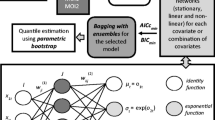Abstract
The Lagos annual maximum rainfall is modeled by the generalized extreme value distribution. Hydrologic risk measures like the probability of exceedance or recurrence, return period, and return level is given.




Similar content being viewed by others
References
Holmes P (1985) Nigeria: giant of Africa. National Oil and Chemical Marketing Co. of Nigeria, Abuja
Hartley J, Potts J, Flew T, Cunningham S, Keane M, Banks J (eds) (2012) Key concepts in creative industries. Sage, Beverley Hills
Anheier HK, Isar YR (eds) (2012) Cultures and globalization: cities, cultural policy and governance. Sage, Beverley Hills
Cunningham S (2013) Hidden innovation: policy, industry and the creative sector. University of Queensland Press, Brisbane
Diop S, Barusseau JP, Descamps C (eds) (2014) The land/ocean interactions in the coastal zone of West and Central Africa. Springer, Berlin
Campbell J (2012) This is Africa’s new biggest city: Lagos, Nigeria, population 21 million. The Atlantic, Washington DC. Retrieved 23 Sept 2012
Nwagwu I, Oni T (2015) Lagos and its potentials for economic growth. 2 July 2015, Retrieved 26 Oct 2015. https://ng.boell.org/2015/07/02/lagos-and-its-potentials-economic-growth
Lees L, Shin HB, Lopez-Morales E (eds) (2015) Global gentrifications: uneven development and displacement. Policy Press, Bristol
Rajewski B (1999) Cities of the world: a compilation of current information on cultural, geographical, and political conditions in the countries and cities of six continents, based on the Department of State’s. Gale Research Co, Farmington Hills
Ayoade JO, Akintola FO (1980) Public perception of flood hazard in two Nigerian cities. Environ Int 4(4):277–280
Israel AO (2017) Nature, the built environment and perennial flooding in Lagos, Nigeria: the 2012 flood as a case study. Urban Clim 21:218–231
Mallikarjuna P, Jyothy SA, Hemanath K (2011) Probability distribution analysis of maximum hourly ranifall intensity—a case study. Hydrol J 34(1&2):42–49
Mayooran T, Laheetharan A (2014) The statistical distribution of annual maximum rainfall in Colombo District. Sri Lankan J Appl Stat 15(2):107–130
Yusof F, Hui-Mean F (2012) Use of statistical distribution for drought analysis. Appl Math Sci 6(21):1031–1051
Chikobvu D, Chifurira R (2015) Modelling of extreme minimum rainfall using generalised extreme value distribution for Zimbabwe. S Afr J Sci 111(9–10):01–08
Sharma MA, Singh JB (2010) Use of probability distribution in rainfall analysis. NY Sci J 3(9):40–49
Nadarajah S, Choi D (2007) Maximum daily rainfall in South Korea. J Earth Syst Sci 116(4):311–320
Agbonaye AI, Izinyon OC (2017) Best-fit probability distribution model for rainfall frequency analysis of three cities in south eastern Nigeria. Niger. J. Environ. Sci. Technol 1(1):34–42
Anandan V (2014) Comparison of probability distributions for frequency analysis of annual maximum rainfall. IJRIT 1(3):50–55
Ho MK, Yusof F (2013) Determination of best-fit distribution and rainfall events in Damansara and Kelantan, Malaysia. Matematika 29:43–52
Li Z, Li Z, Zhao W, Wang Y (2015) Probability modeling of precipitation extremes over two river basins in northwest of China. Adv Meteorol. https://doi.org/10.1155/2015/374127
Koutsoyiannis D, Baloutsos G (2000) Analysis of a long record of annual maximum rainfall in Athens, Greece, and design rainfall inferences. Nat Hazards 22(1):29–48
Koutsoyiannis D (2004) Statistics of extremes and estimation of extreme rainfall: II. Empirical investigation of long rainfall records/Statistiques de valeurs extrémes et estimation de précipitations extrêmes: II. Recherche empirique sur de longues séries de précipitations. Hydrol Sci J 49(4):591–610
Li Y, Cai W, Campbell EP (2005) Statistical modeling of extreme rainfall in southwest western Australia. J Clim 18(6):852–863
Nadarajah S (2005) Extremes of daily rainfall in West Central Florida. Clim Change 69(2):325–342
Fisher RA, Tippett LHC (1928) Limiting forms of the frequency distribution of the largest or smallest member of a sample. In: Mathematical proceedings of the Cambridge Philosophical Society, vol 24, no. 2. Cambridge University Press, pp 180–190, Apr 1928
Kotz S, Nadarajah S (2000) Extreme value distributions: theory and applications. World Scientific, Singapore
Beirlant J, Goegebeur Y, Segers J, Teugels J (2006) Statistics of extremes: theory and applications. Wiley, London
Leadbetter MR, Lindgren G, Rootzén H (2012) Extremes and related properties of random sequences and processes. Springer, Berlin
Coles S, Bawa J, Trenner L, Dorazio P (2001) An introduction to statistical modeling of extreme values, vol 208. Springer, London
de Haan L, Ferreira A (2007) Extreme value theory: an introduction. Springer, Berlin
Cramér H (1928) On the composition of elementary errors. Almqvist & Wiksells, Stockholm
Von Mises R (1928) Stat Wahrh. Julius Springer, Berlin
Anderson TW, Darling DA (1952) Asymptotic theory of certain “goodness of fit” criteria based on stochastic processes. Ann Math Stat 23:193–212
Wilcox R (1998) Kolmogorov–Smirnov test. In: Armitage P, Colton T (eds) Encyclopedia of biostatistics, vol 3. Wiley, Chichester, pp 2174–2176
Liao M, Shimokawa T (1999) A new goodness-of-fit test for type-I extreme-value and 2-parameter Weibull distributions with estimated parameters. Optimization 64(1):23–48
Cox DR, Stuart A (1955) Some quick sign test for trend in location and dispersion. Biometrika 42:80–95
Mann HB (1945) Nonparametric test against trend. Econometrica 13:245–259
Kendall M (1990) Rank correlation methods, 5th edn. Oxford University Press, New York
Wald A, Wolfowitz J (1940) On a test whether two samples are from the same population. Ann Math Stat 11:147–162. https://doi.org/10.1214/aoms/1177731909
Moore GH, Wallis WA (1943) Time series significance tests based on signs of differences. J Am Stat Assoc 38:153–154
Bartels R (1982) The rank version of von Neumann’s ratio test for randomness. J Am Stat Assoc 77(377):40–46
Soukissian TH, Tsalis C (2015) The effect of the generalized extreme value distribution parameter estimation methods in extreme wind speed prediction. Nat Hazards 78(3):1777–1809
Acknowledgements
The authors are thankful to the Editor and reviewers for their careful reading, invaluable comments, and suggestions which significantly improved the paper.
Author information
Authors and Affiliations
Corresponding author
Appendix
Appendix
Rights and permissions
About this article
Cite this article
Okorie, I.E., Akpanta, A.C., Ohakwe, J. et al. A Note on Modeling the Maxima of Lagos Rainfall. Ann. Data. Sci. 6, 341–359 (2019). https://doi.org/10.1007/s40745-018-0161-4
Received:
Revised:
Accepted:
Published:
Issue Date:
DOI: https://doi.org/10.1007/s40745-018-0161-4





